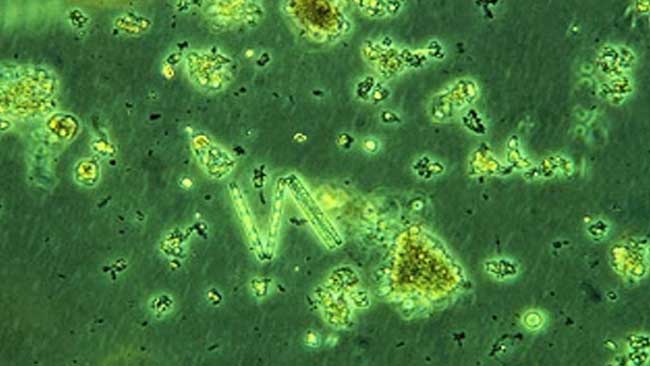Nowadays, there has been a rapid development in aquaculture activities indicated by an increase in fishery production, and a decline in capture fisheries production. Therefore, aquaculture is suggested as an alternative that can be relied upon and developed (Mukti et al., 2003). Today, many individuals rely on fisheries and aquaculture for food needs and as a source of income.
In such a situation, aquaculture meets several challenges, especially those related to natural resources, such as water and land. The application of intensive cultivation patterns has become a possible choice in increasing aquaculture production. Although several efficient measures have been taken to develop aquaculture, especially intensive systems, there is still a need to examine such constraints. Amongst, these are aquaculture waste discharges, the use of fish meal as raw material for artificial feed, and the spread of diseases. Intensive aquaculture systems are carried out efficiently to produce solid biomass in fish or shrimp. However, the intensive aquaculture industry faces two main problems, the first is the decline in water quality caused by high concentrations of metabolites, and second, the utilization of low natural feed in aquaculture activities with high water exchange intensity (Wyk and Avnimelech, 2007).
Promoting a zero-exchange-water system can be an efficient step to reduce the negative impact, so as to reduce the risk of pollution by aquaculture wastes (Crab et al., 2009). As reported, the process of decomposition of organic matter by aerobic bacteria will cause a decrease in oxygen content in water, and the accumulation of organic matter in the pond will increase the population of bacteria in pond water (Avnimelech et al., 2008). As a result, there is a need to change toxic nitrogen compounds (ammonia) to nitrate by applying biofloc technology (Avnimelech, 1999). Biofloc technology maximizes the contribution of natural food and increases aquaculture production (Ogello et al., 2014). Biofloc production depends on the supply of organic substrates, either external sources (feed supply, algal activity) or with residual excretions by fish. The process of biofloc formation is also influenced by environmental conditions, such as temperature and salinity (Wyk and Avnimelech, 2007). With this in mind, the current study investigated the effect of two commercial probiotics on the diversity of phytoplankton associated with biofloc. The study was conducted by forming biofloc using two different commercial probiotics, namely commercial probiotics B and commercial probiotics C, then floc sampling was taken to observe the diversity of phytoplankton.
All experimental protocols and procedures were approved by the Institutional Animal Care of Indonesia. The current experimental method was conducted using an observation under artificial conditions, in which conditions were created and regulated by researchers. To obtain accurate results, the study was conducted at the Educational Laboratory of the Faculty of Fisheries and Maritime Affairs, Universitas Airlangga, Surabaya in Indonesia. The examination of the Carbon/Nitrogen (C/N) and Nitrogen/Phosphorus (N/P) ratio of the water was conducted at the Environmental Quality Laboratory of the Faculty of Civil Engineering and Planning, Sepuluh November Institute of Technology Surabaya in Indonesia. The research was conducted from March to April 2015.
The applied instruments in the current study included aquarium measuring 40×20×35 cm3, cone glass tube (Imhoff cone), aerator, aeration stone, aeration hose, analytical balance, pipette, pH meter, thermometer, Dissolved oxygen kit, ammonia kit, hemocytometer, cover glass, and microscope. In addition, the utilized materials were two kinds of probiotics (probiotics B and C) produced by containing Bacillus spp., lactic acid, Lactobacillus spp., Saccharomyces spp., molasses, fish pellets, bran, chlorine, and dolomite.
The experimental design used by researchers was a completely randomized design. In this design, there was only one source of diversity, namely treatment in addition to random effects, so the results of differences among treatments were only due to the effects of treatment and random effects. For this reason, this experiment consisted of three treatments, namely treatments A, B, and C. Treatment A contained biofloc formation without using probiotics, the treatment B involved biofloc formation using commercial probiotics (Bacillus spp., lactic acid, Lactobacillus spp., Saccharomyces spp. 50/50 feed), and treatment C entailed biofloc formation using commercial probiotics (containing a native microbial consortia, 50/50 feed ), which were repeated six times leading to 18 experimental units, namely: A1, A2, A3, A4, A5, A6, B1, B2, B3, B4, B5, B6, C1, C2, C3, C4, C5, and C6. Formulation of probiotics/feed was according to Arias-Moscoso et al. (2018).
The pH value describes the acidity and alkalinity intensity of water samples indicated by the presence of hydrogen ions. Most aquatic biotas are sensitive to changes in pH, and prefer a pH value of around 7-8.5. The pH value also greatly influences the biochemical processes of the water samples, such as nitrification. At pH < 4, most aquatic plants die (Effendi, 2003). On the other hand, it is known that water with a pH of 6-9 is highly fertile, and is considered productive since the pH range of water can encourage the process of dismantling organic matter into minerals that can be assimilated by phytoplankton (Odum, 1953). For this reason, pH measurements in this study were carried out at 06.00 in the morning and 17.00 in the afternoon. The weekly dynamics of pH were measured along with ammonia at the beginning of the study.
CREATED BY : ENDANG DEWI MASITHAH
More detailed information from this research can be found in scientific journals at the following link:





